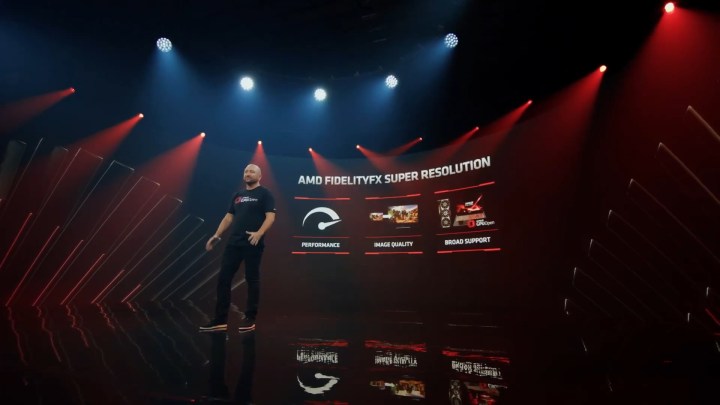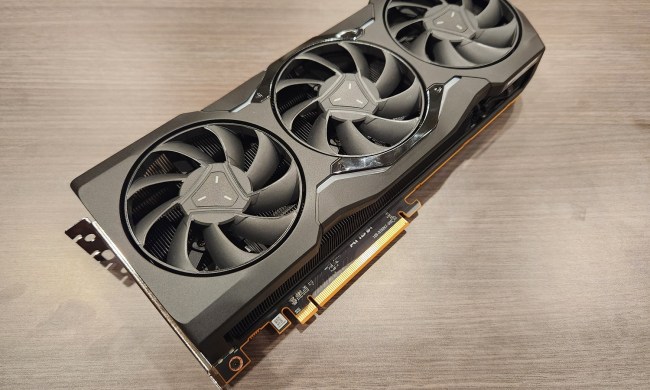Computex 2021 brought big announcements from AMD, Nvidia, and Intel. Following major product launches last year, all three tech giants announced new products during their respective keynotes, some of which will be available in the following weeks.
To get you up to speed, we rounded up everything announced from AMD, Nvidia, and Intel at Computex 2021. From the RTX 3080 Ti to FidelityFX Super Resolution to a new NUC, there’s a lot to look forward to in 2021 and beyond.
Nvidia: RTX 3080 Ti, Superpod subscriptions, and more

Nvidia spent a lot of its talk focusing on gaming, and for good reason. The big announcement out of the keynote was the RTX 3080 Ti and 3070 Ti, which are set to release later in June, but there were a few other exciting announcements along the way.
Nvidia announced several new games supporting RTX features. The two big ones are Rainbow Six: Siege and Red Dead Redemption 2, both of which will receive Nvidia DLSS for a performance boost. Nvidia also showed off Dying 1983 and Icarus First Cohort, which will receive RTX ray tracing when they launch. Doom Eternal will also receive RTX support with ray tracing and DLSS.
RTX is also coming to a limited slate of VR games. Nvidia announced that No Man’s Sky, Wrench, and Into the Radius will receive the RTX bells and whistles in VR soon.
One of Nvidia’s key focuses for its Computex 2021 keynote was “democratizing A.I.,” and that democratization comes through the DGX Superpod subscription platform. For $90,000 per month, businesses can harness the power of Nvidia’s DGX 2 supercomputer while accessing a host of software through Nvidia’s A.I. Enterprise software suite.
While $90,000 sounds like a lot, when you consider that the DGX 2 launched at a price of $399,000, it doesn’t look so bad. Nvidia didn’t announce a launch date but said businesses will know more about the platform this summer.
Gamers also have a lot to be excited about — Nvidia is launching two new graphics cards. The RTX 3080 Ti and 3070 Ti bring improvements to Nvidia’s already powerful Ampere lineup, and they’re releasing soon. The RTX 3080 Ti is set to launch on June 3 for $1,199 and the RTX 3070 Ti will come a week later on June 10 for $599.
The RTX 3080 Ti is basically a reskinned RTX 3090. Although it comes with half the video memory, the RTX 3080 Ti comes with nearly as many CUDA cores, Tensor cores, and RT cores as Nvidia’s $1,500 behemoth of a GPU. The RTX 3070 Ti shows less of an improvement over the base model, though it comes with much faster GDDR6X video memory.
AMD: Ryzen 5000 APUs, Super Resolution, and stacking chiplets

AMD laid out its plans for the rest of the year and beyond during its keynote. The talk brought several exciting product announcements, including the announcement of FidelityFX Super Resolution.
After talking about strides in the data center, AMD began its keynote with the announcement of two new Ryzen 5000 APUs — the Ryzen 7 5700G and Ryzen 5 5600G. These updated chips come with RDNA 2 graphics cores alongside Zen 3 CPU cores. Together, they can deliver playable frame rates in AAA titles without a dedicated graphics card.
AMD showed off the performance of the 5700G, saying the processor could deliver an average of 78 frames per second (fps) across a variety of titles at High settings at 1080p. Both chips are set to launch on August 5, with the 5700G costing $395 and the 5600G costing $259.
AMD’s Scott Herkelman took over after the Ryzen 5000 APU announcement to talk about RX 6000M mobile graphics cards. AMD announced three cards based on the RDNA 2 architecture — the RX 6800M, 6700M, and 6600M. The 6800M targets 120 fps at 1440p for full-sized laptops. The 6700M is targeting 100 fps at 1440p in full-sized laptops, and the 6600M is targeting 100 fps at 1080p in lightweight laptops.
All three cards bring a slew of AMD technologies to notebooks. That includes the FidelityFX suite, including Super Resolution, Smart Access Memory, AMD Infinity Cache, and SmartShift, which can dynamically shift between Radeon graphics and Ryzen processors to increase gaming performance.
A big topic of discussion going into AMD’s keynote was FidelityFX Super Resolution (FSR), and sure enough, AMD officially launched it. FSR is AMD’s answer to Nvidia’s DLSS, promising up to a two and a half times performance increase at 4K in supported games.
FSR comes with four quality modes, each of which upscale games from a smaller internal render size. Through a complicated process of neural networks and algorithms, AMD is able to deliver higher frame rates with demanding features like ray tracing while keeping most of the image quality intact. FSR is set to release on June 22.
AMD ended the keynote talking about the future — 3D V-Cache. By stacking 64MB of cache on top of the core die, AMD is able to deliver triple the amount of L3 cache. That’s 192MB up from 64MB, which is a huge jump. At 1080p, a Ryzen 5900X with the expanded cache delivered a 15% performance improvement while gaming.
Although not a gen-on-gen leap, the new technology is promising for AMD’s upcoming processors. AMD CEO Lisa Su said that products with 3D chiplets will be out by the end of the year.
Intel: New Tiger Lake processors and 5G

Intel focused much of its keynote on the pandemic and how it is investing in the future of domestic semiconductor manufacturing. Thankfully, Intel had a few exciting announcements sprinkled in to give enthusiasts something to look forward to.
Intel announced a new initiative to bring 5G connectivity to Windows laptops. Intel 5G 5000 will allow laptops to connect to the network globally, and the first laptops with Intel’s chip will start rolling out later this year.
The M.2 5G card has worldwide carrier certification, allowing laptops with the chip to connect to the network virtually anywhere. Acer, Asus, and HP already have laptops in the works for this year, and Intel says more than 30 laptops featuring the chip will arrive through 2022.
After talking about the pandemic’s effect on supply chains, Intel moved quickly into announcing its Sapphire Rapids Xeon scalable platform, which is set to launch next year. These server processors are already with some of Intel’s key customers, but the full launch won’t happen until 2022.
Intel also showed off two new Tiger Lake-U chips, promising a significant uptick in performance on thin and light laptops. The Core i7-1195G7 headed the lineup, delivering up to a 5GHz clock speed across four cores and eight threads. Intel also announced the i5-1155G7, which also has four cores and eight threads, though it can only turbo to 4.5GHz.
Both processors come with Xe graphics, with 80 execution units (EUs) on the 1155G7 and 96 EUs on the 1195G7. Intel says more than 60 laptop models featuring the new chips will be out by the end of the year.
Rounding out the keynote, Intel announced the “Best Canyon NUC.” Intel says more information is coming later this year, but for now, we know that the NUC 11 Extreme kit is powered by Tiger Lake-H processors and that this is the first NUC to support full-length discrete graphics cards.
It’s also the first to bear an RGB skull on the front.




